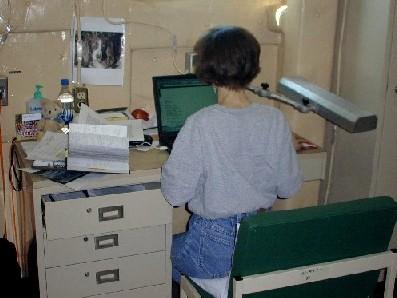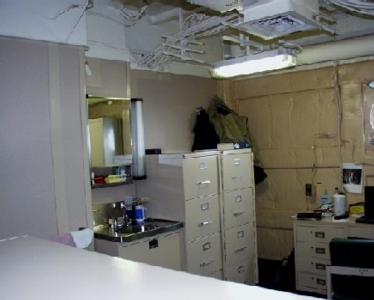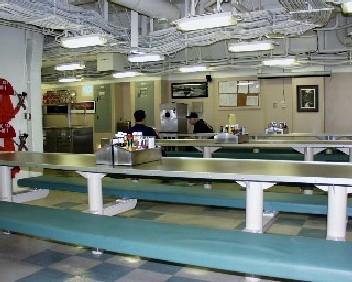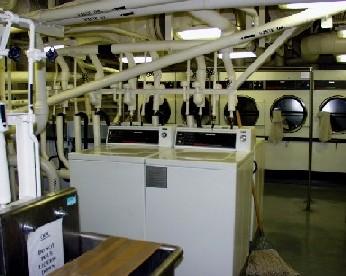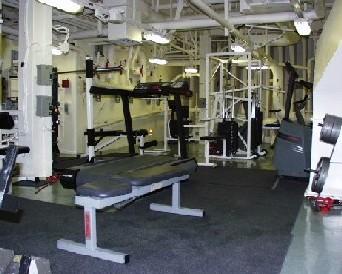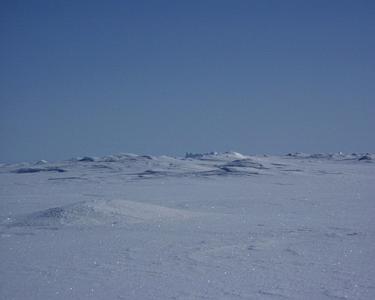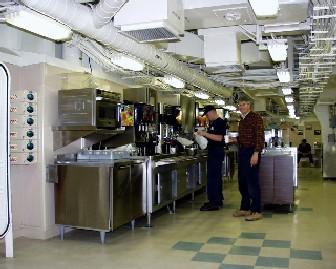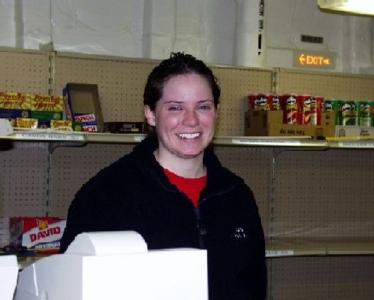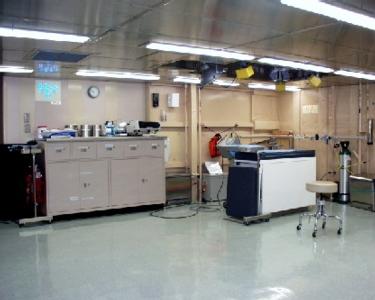
|
13 May, 2000Saturday Notes DRAFT May 13, 2000 Daily Data (20:30): Lat. 6713.267854N Long. 06004.031384W Heading 208.010 deg Air Temp. -7.03C 19.35F True Wind Dir. 000 deg True Wind Speed 14 knots (Note: The heading is the direction the bow of the ship is pointing at any instant expressed in degrees from 000 degrees through 360 degrees. Course is the intended direction of the ship and at a specified time may or may not coincide with the heading.) USCGC Healy Facts Living spaces dedicated to the Science Community: chief scientist stateroom and conference center scientist staterooms (2 person) science leisure area (lounge, library, conference room) Living spaces dedicated to the Ship's Crew: C.O. cabin and stateroom officer staterooms (2 person) CPO staterooms (2 person) enlisted berthing (4 and 6 person) leisure areas consisting of officer lounge, CPO lounge, crew lounge Common living spaces: messing facility laundry gym ship's store medical treatment Dear Everyone, I'm now a Polar Bear! Officially. By the rites of the Solemn Mysteries of the Ancient Order of the Deep and by decree of King Neptune. The best thing about the Blue Nose Initiation is that it's over! Let's just say that the rites were everything they were promised to be. And, yes, I'm glad I did it. Last night I took a breather from the non-talent show and stepped out to the flight deck to enjoy the beauty of my surroundings. The evening light was low with mixed tinges of pink in its yellow glow illuminating the ice sheet surfaces and reflecting from the leads. I found Stevie Audlakiak taking in the views. After a few moments, he called to me, “Sandra, Narwhals!” Sure enough. We watched two hefty creatures float casually at the surface, dip and spout repeatedly. Puffins joined the scene and when I finally walked away, I contemplated that nothing could be better. Regrettably, our Inuit language lessons are now over. Both Stevie Audlakiak and James Qillaq departed this afternoon by Healy helicopter for Broughton Island, Stevie's home. James will await his Monday flight connection from Broughton Island to his home in Clyde River. Stevie's wife, Mary, is an elementary school teacher. Mary is teaching Kindergarten and first grade this year. During the previous school year, Mary taught grades 3, 4, and 5. Stevie asked me if there are any teachers that would like to have their students exchange hard copy (he tells me email is not possible) letters with the students at Mary's school. I told him I'd ask. If you are a teacher and would like this activity for your students, then this is Stevie Audlakiak's and Mary's mailing address: Broughton Island, Northwest Territories, X0A 0B0. Around mid-day, the Healy rammed and broke a ridge of first-year ice that was measured late yesterday to be 48 feet at its thickest point. The average thickness of this ridge was approximately 25 feet. The Healy successfully rammed and broke through this ridge in an area 45-feet thick requiring only three attempts. Observers filled the bridge to watch this thrilling event. Vocabulary of the day: >From MANICE; Manual of Standard Procedures for Observing and Reporting Ice Conditions, Canadian Ice Service, April 1994. Ridge: A line or wall of broken ice forced up by pressure. It may be fresh or weathered. Ice Keel or Keel: The submerged volume of broken ice under a ridge that is forced downward by pressure. New Ridge: Ridge with sharp peaks and slope of sides usually 40 degrees or more. Fragments are visible from the air at low altitude. Weathered Ridge (this is a repeat of journal 05/09/00): Ridge with peaks slightly rounded and slope of sides usually 30 to 40 degrees. Individual fragments are not discernible. Consolidated Ridge: A ridge in which the base has frozen together. Vocabulary from Terry Tucker, present Healy Co-Chief Scientist and from the Cold Regions Research and Engineering Laboratory (CRREL), Hanover, NH: Sail: The visible peak of a ridge. Note on Keel’: Terry also adds that the keel is roughly considered to be four times the thickness of the sail. How are multi-year ice ridges different from first-year ridges? In terms of icebreaking ships, multi-year and first-year ridges are frequently challenging, but for differing reasons. First-year ice ridges are not as consolidated as multi-year ice in ridges. Multi-year ice ridges have had fall and winter and perhaps years to freeze solidly. In first-year ice ridges, large blocks or chucks of ice created by the pressure and breaking up of the floe can be observed. These blocks are not yet frozen together. Because multi-year ice ridges pass through spring and summer, both the sail and the keel become rounded due to some melting from the warming of summer. Due to this melting, multi-year ridges can be smaller than first-year ridges, but denser and more consolidated from their extended length of freezing time. A first-year ridge, on the other hand, is generally thicker than a multi-year ridge because this melting has not occurred. Following you will find data on ice core number 1A of April 10, 2000. Best regards, Sandra Core 1A Ice 0410, First testing floes, beginning of test 10-April-00 Total length 60 cm Latitude 63 deg 18.67 min Longitude 62 deg 09.63 min Comments: Break at 35 cm, air temp -12C, 25 cm ice temp interpolated for missing temp due to crack. Brine volume for -2>T>-22.9 Brine volume coefficients F1(T) COEF. -4.732 -22.450 -0.640 -0.011 F2(T) COEF. 8.90E-02 -0.018 -0.001 0.000
Average brine vol 0.0863 Average strength mpa 0.313 Average strength psi 45.4 For photos and more: ../tea_kolbfrontpage.html For further information: ../ http://www.uscg.mil./pacarea/healy
Contact the TEA in the field at . If you cannot connect through your browser, copy the TEA's e-mail address in the "To:" line of your favorite e-mail package. |




